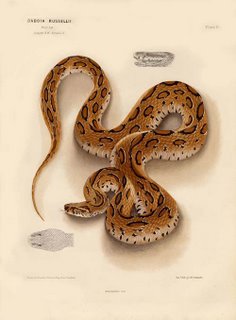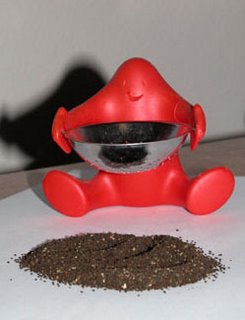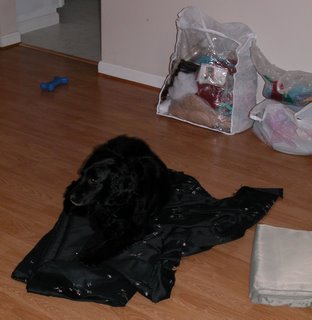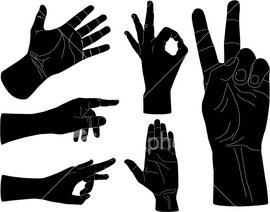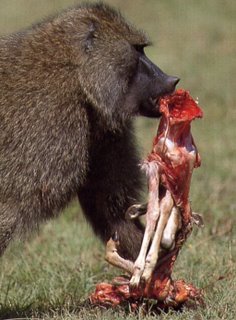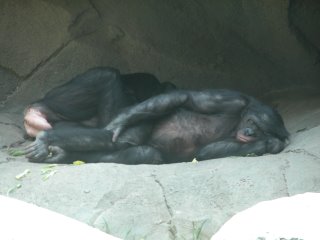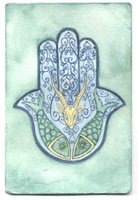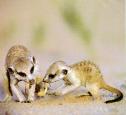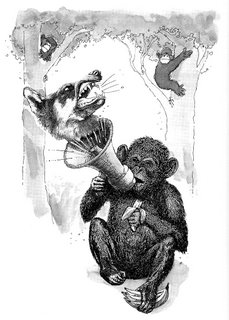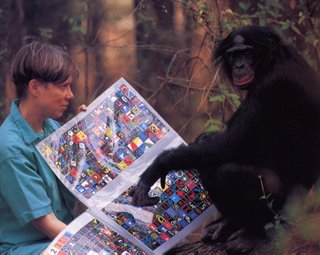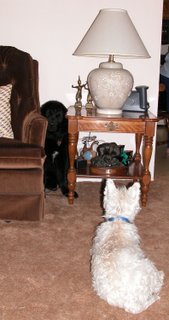... than primate brains.
At least when the fly education is delivered via the Discovery Channel and the primate brain information is delivered via an unnecessarily redundant and narrow article about how the number of cones in a primate's fovea is correlated with its brain size.
To make a long story short, I read the other article I alluded to in my previous post. It appears in the 51st issue of the Journal of Human Evolution. Kirk provided data that shows that for the most part, throughout primate evolution the size of the optic foramen is associated with total brain size.

The optic foramen is the opening in the skull through which the optic nerve passes. The photo to the right, from an NIH website, illustrates the whereabouts of this thing. Why do primate have such large brains relative to other animals? And, why do anthropoids (monkeys & apes) have such large brains compared to strepsirrhines (wet nosed prosimians like lemurs and bushbabies)? They receive more "visual input" to the brain because of having more cones in their retinas which forced (because of Jerison's principle of proper mass) their brains to become larger to accommodate the need to process more info coming in through their eyeballs, i.e. primates have big brains because they have sharp eyes.
The author, E. C. Kirk, barely offers a reason for why primates have greater visual acuity (more cones in their retinas). He defers to the prevailing theory of visual predation. Perhaps the editors of the journal excised that part to make room for Isbell's seriously long article...

Aside from learning that a huge proportion of the neocortex is devoted to visual information processing, I also learned some more about
aye-ayes and
night monkeys, two oddballs in the primate world.
First, the aye-aye and the
night monkey don't fit the equation for the visual acuity/big brain relationship.
The aye-aye's brain is much larger than it should be, and the night monkey, despite having few cones in its retina, does NOT have a smaller brain than it should, so like the aye-aye, its brain is larger than it should be. Cool. "Clearly, factors other than increased visual input are responsible for the evolution of high encephalization in
Daubentonia" (Kirk, 2006, 86). Yeah, like maybe instead of depending on visual predation, it relies on auditory predation.
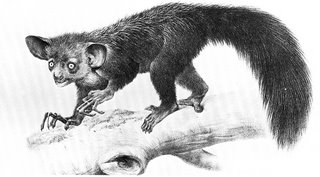
This beautifully ugly little bugger uses echolocation by tapping on tree limbs to locate nutritious grubs inside. Then, with its rodent-like incisors it gauges a hole in exactly the right spot and uses its incredibly long middle finger to winkle out the worm. The aye-aye's brain is also more heavily convoluted than it ought to be. Perhaps its auditory cortex or whatever part of the brain deals with spatial locations is disproportionately large. Meanwhile, the nocturnal and incredibly large eyed Aotus may have a large brain because of the "
ratchet effect," the tendency for brains to stay large once they've evolved to that size because of the cognitive advantages (which presumably outweigh the metabolic cost of maintaining it).
Big brains are like SUVs, they need a lot of gas to go. If you're a small bodied primate, your tank isn't very large so if you're going to run a large brain, you'd better be ingesting some high octane fuel. Because large brains are so costly, many scientists have pondered why they become so large.
Finally, I wanted to talk about flies (actually MAGGOTS) so here goes!
This will be comparatively short and less than erudite because A, I am no Drosophila expert, and B, I got it from the Discovery Channel.

1. TSETSE FLIES (the nasty vermin that cause African Sleeping Sickness) give live birth to single young larvae which develop some sort of airbag on their forehead which presumably blows them away... maybe so they don't compete for prey with mom? The sickness is caused by a trypanosome, a parasite, that quickly migrates to the brain and eventually causes the afflicted to be perpetually and seriously drowsy. The program reported that 50 million people may be affected but the CDC reports that the figure is closer to 400,000. Of interest to me, being someone who would like to visit Mali someday to see
the largest mud structure in the world and listen to music following in the tradition of
Ali Farka Toure,
the CDC also reports:
 "African trypanosomiasis is confined to tropical Africa between 15° north latitude and 20° south latitude, or from north of South Africa to south of Algeria, Libya, and Egypt... Tsetse flies inhabit rural areas, living in the woodland and thickets of the savannah and the dense vegetation along streams [i.e places where two birdwatchers could find themselves]. Infection of international travelers is rare [great news!]. Approximately 1 case per year is reported among U.S. travelers. Most of these infections are caused by T. b. rhodesiense and they are acquired in East African game parks. Travelers visiting game parks and remote areas should be advised to take precautions. Travelers to urban areas are not at risk [no problem, I will be spending ZERO time in Lagos]."
"African trypanosomiasis is confined to tropical Africa between 15° north latitude and 20° south latitude, or from north of South Africa to south of Algeria, Libya, and Egypt... Tsetse flies inhabit rural areas, living in the woodland and thickets of the savannah and the dense vegetation along streams [i.e places where two birdwatchers could find themselves]. Infection of international travelers is rare [great news!]. Approximately 1 case per year is reported among U.S. travelers. Most of these infections are caused by T. b. rhodesiense and they are acquired in East African game parks. Travelers visiting game parks and remote areas should be advised to take precautions. Travelers to urban areas are not at risk [no problem, I will be spending ZERO time in Lagos]."
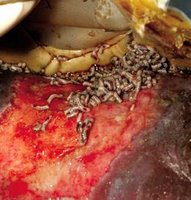
2. Maggots are used to keep wounds clean and can be very helpful for treating gangrene when other methods (antibiotics and surgery) fail.
Maggot therapy in the UK is such big business, at least according to the Discovery Channel, that it's an 11.5 million/year industry there. If they inflated these numbers like they did with the alarmist tsetse fly numbers, then the real figure may be closer to 100,000. Maggot factories employ owls to catch the escapees. What a great natural solution to two gross problems. I couldn't help but to think of the scene from The Gladiator...
3. An unidentified Mexican woman believes, "Flies and insects are the answer to word famine." She says maggots provide 50% more protein than beef and can be digested more easily. She even promos
a recipe book that she wrote which contains instructions for making a substitute cream sauce for ratatouille out of pureed maggot innards. Primates were originally insectivores so maybe she's on to something....
... if you're an AYE-AYE!
Entomophagy - YUCK
Coprophagy - DOUBLE YUCK
Steakophagy.... YUM.
By the way, according to Dictionary.com, coprophagy is "the eating of excrement that is normal behavior among many especially young animals but in humans is a symptom of some forms of insanity."
As is eating maggot cream sauce on your pasta!
Seriously, I don't think eating shit makes you certifiably insane, nor does consuming bugs.
Would you eat maggot cream sauce?
What if it could be made to taste just like the cream sauce the guys over at
Cafe Medit make for their lobster ravioli?
 Every once in a while when I am reminded that I live in a Puritanical sex-repressed insensitive patriarchal country, I get angry enough that I want to do something about it.
Every once in a while when I am reminded that I live in a Puritanical sex-repressed insensitive patriarchal country, I get angry enough that I want to do something about it. 







